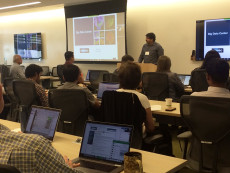NERSC Hosts First ‘Big Data Summit’
July 20, 2018
Some 75 researchers and data scientists attended the Big Data Summit 2018, hosted July 18 at Lawrence Berkeley National Laboratory by the National Energy Research Scientific Computing Center (NERSC).
Co-organized by NERSC, Intel and Cray, the inaugural event featured a series of presentations highlighting results from advanced data analytics and management projects on NERSC’s Cori supercomputer. The projects are being led by NERSC, Intel, Cray and five Intel Parallel Computing Centers (IPCCs).
“Over the past year, the Big Data Center collaboration has made strong strides in pushing the frontier of capability applications on the Cori platform,” said Prabhat, who leads the Data and Analytics Services team at NERSC and helped organize the summit. “The Big Data Summit was held to share our results with the broader community, solicit feedback and foster new collaborations. Active participation from Intel, Cray and the IPCCs—all members of the Big Data Center collaboration—made this event a big success, and we are looking forward to new results in the future.”
The day-long event, which was live-streamed (the slides and video will be posted on the NERSC website soon), included 13 plenary and invited talks and a poster session:
- “Big Data Center,” Prabhat, NERSC
- “HPC and ML – The New Frontier of Compute,” Victor Lee, Intel
- “Data Science and Machine Learning at Supercomputer Scale,” Mike Ringenburg, Cray
- “Distributed Training of Generative Adversarial Networks for Fast Detector Simulation on Intel Xeon HPC Cluster,” Vikram Saletore and Hans Pabst, Intel; Damian Podareanu and Valeriu Codreanu, SURFsara B.V.; Sofia Vallecorsa and Federico Carminati, CERN
- “Deep Probabilistic Models for Astronomy,” Jeffrey Regier, University of California, Berkeley
- “Project DisCo: Physics-based Discovery of Coherent Structures in Spatiotemporal Systems,” Adam Rupe, James P. Crutchfield and Ryan G. James, University of California, Davis
- “Working Towards Distributed Inference Compilation at Scale,” Frank Wood, University of British Columbia (formerly Oxford University)
- “Neutrino Detection with Graph Neural Networks,” Nicholas Choma and Joan Bruna, New York University
- “Machine Learning and Topological Data Analysis: Applications to Pattern Classification in Fluid and Climate Simulations,” Vitaliy Kurlin and Grzegorz Muszynski, University of Liverpool
- “Deep Dive into TensorFlow: Single and Multi-Node Optimizations on Intel Xeon,” Ashraf Bhuiyan, Intel; Steven Farrell, NERSC
- “High Productivity Languages – Python,” Heidi Pan, Intel; Rollin Thomas, NERSC
- “CosmoFlow: Using Deep Learning to Learn the Universe at Scale,” Debbie Bard, NERSC
- “Data Management and I/O Deep Dive,” Quincey Koziol, NERSC
About NERSC and Berkeley Lab
The National Energy Research Scientific Computing Center (NERSC) is a U.S. Department of Energy Office of Science User Facility that serves as the primary high performance computing center for scientific research sponsored by the Office of Science. Located at Lawrence Berkeley National Laboratory, NERSC serves almost 10,000 scientists at national laboratories and universities researching a wide range of problems in climate, fusion energy, materials science, physics, chemistry, computational biology, and other disciplines. Berkeley Lab is a DOE national laboratory located in Berkeley, California. It conducts unclassified scientific research and is managed by the University of California for the U.S. Department of Energy. »Learn more about computing sciences at Berkeley Lab.








